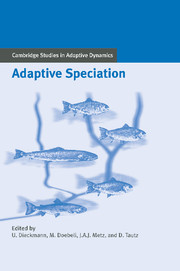2 - Speciation in Historical Perspective
Published online by Cambridge University Press: 05 July 2014
Summary
Introduction
By the time Darwin died in 1882, evolution by descent was widely hailed, never again to be challenged by the vast majority of biologists. His theory of natural selection as the key to understanding adaptation, however, was less successful. Alfred Russel Wallace's Darwinism, which strongly defended natural selection, appeared soon after Darwin's death (Wallace 1889). Detractors of natural selection increased in strength during the 1890s; indeed, historian Peter Bowler termed the period close around the turn of the century as “the eclipse of Darwinism” (Bowler 1983). A contemporary biologist billed this period, more graphically as, “the deathbed of Darwinism” (Dennert 1903). Even Wallace, in his old age, began to backpedal from natural selection toward belief in god-designed organisms (Wallace 1910). Beginning with the “evolutionary synthesis” of the 1930s and 1940s, Darwin's natural selection enjoyed a rebirth, and became known as “Twentieth Century Darwinism,” the name made famous by the 1959 Cold Spring Harbor Symposium Genetics and Twentieth Century Darwinism (Mayr 1959a).
Evolution produces two major results: adaptations and biodiversity. Natural selection loomed large in the mid-20th century as the explanation of adaptive design, but Darwin's ideas about species and speciation simultaneously were driven to obscurity, where they have remained. The argument here is that “21st Century Darwinian Speciation” is emerging from the darkness of the past half-century.
- Type
- Chapter
- Information
- Adaptive Speciation , pp. 17 - 30Publisher: Cambridge University PressPrint publication year: 2004
- 1
- Cited by

